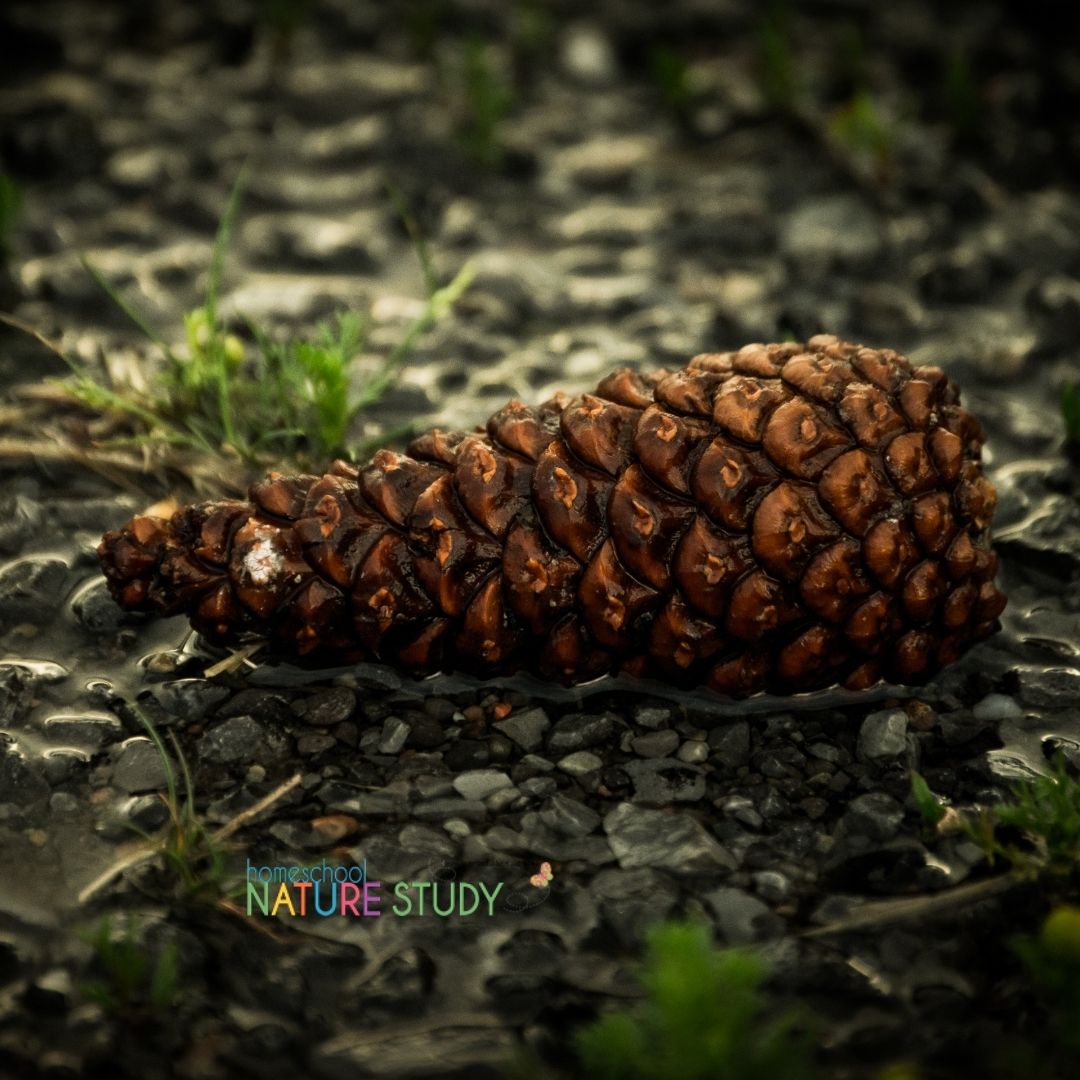
This homeschool nature study has everything you need to start learning about pine trees and pine cones. This Outdoor Hour Challenge is based on the Winter Wednesday curriculum which is available to our members but you can follow along regardless using this post as a bit of a guide. In the Winter Wednesday curriculum you will have access to notebooking pages and a host more ideas and links.
Let’s jump into exploring pine trees and pine cones in nature…

This challenge was originally written using the Discover Nature in Winter book which you can grab fairly inexpensively off Amazon in Kindle format. However, I will give you alternatives using the Handbook of Nature Study (this is a link to the free online version if you do not have a copy to hand just yet) too.
Homeschool Nature Study: Pine Trees and Pine Cones
Let’s kick off our studies with a quick Youtube video on pine cones.
Outdoor Hour Challenge for Your Homeschool
1. Read chapter five in Discover Nature in Winter. Once again, this chapter covers more than just cedar trees in its information and activities. As you read the chapter, keep your pen in hand to jot down ideas that come to you as you read the information and the suggested activities.
If you are using the Handbook of Nature Study begin by reading the introductory pages of the pine tree on pages 670-674. Bear this information in mind as you head out for your nature walk. You do not need to bombard your children with information, instead, you will be able to answer their questions and direct their observations.
2. Since this chapter really covers a variety of evergreens, our family will be focusing on our local evergreens as part of this week’s activity. We will be completing two activities to go along with this chapter, one a short term project and one a long term project.
Cone Collection on page 96 (short term)
Tree Community on page 97 (long term)
The Homeschool Pine Cone Collection Activity
For the cone collection, we will be gathering and comparing cones from different evergreens. I love the idea on the top of page 97 to pick a cone and write a description of it in your nature journal. Then you share the description with someone else and they have to figure out which cone you described. Love it!

The Tree Community Activity for Your Homeschool
For the tree community activity, we will be using our backyard sequoia to develop an ongoing list of creatures that use the tree as part of their community. This activity suggests keeping track of when certain birds and animals frequent the tree to see patterns. See page 98 for a sample chart.
Suggested Activities If You Do Not Have A Copy of Discover Nature in Winter
I know that there are homeschool families that are following along without the book but this week’s nature study is one you can complete very easily. Here are some suggestions.
1. Observe and compare the bark of two trees in your yard.
2. Pick a tree you can see from your window and observe any birds or animals that visit over the next week.
3. Collect cones and compare them in your nature journal. See if you can find the seeds inside the cone.
Pine Trees and Pine Cones From the Handbook of Nature Study
Lesson 185 – The Pine – page674-675
- Find a pine tree on your walk and look at it’s shape. Observations 1 -3 of the lesson will guide you on what to look for
- Gather up some pine leaves. Observation 4 provides guidance on your observations
- Collect as many cones as you can to take home. It would be lovely it you could find some closed and some open. Observations 5-6 in the Handbook of Nature Study will give you ideas on what you are looking for.

If you are just getting started in homeschool nature study, be sure to grab our free Getting Started in the Outdoor Challenges Guide!
Join the Homeschool Nature Study Membership for Year Round Support
There are so many benefits to joining. You will access our full range of curriculum, our interactive learning calendar as well as a brand new homeschool nature study challenge post each week!

Connect With Our Homeschool Community On Social Media
Did you enjoy this Outdoor Hour Challenge? Be sure to tag us on Instagram @outdoorhourchallenge and use the hashtag #outdoorhourchallenge so we can see and comment!

































